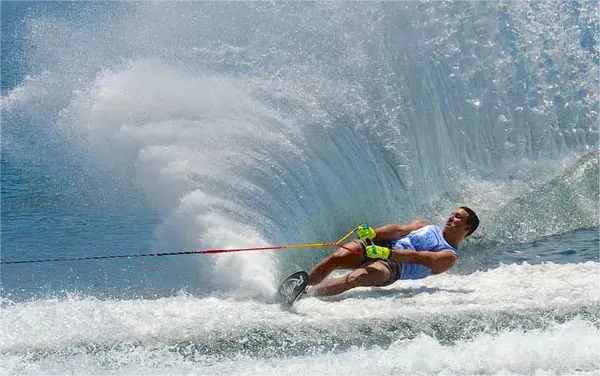In the realm of watersports, where adrenaline meets finesse, slalom water skiing stands out as a pinnacle of precision and skill. With its roots tracing back to the mid-20th century, this exhilarating sport has evolved into a captivating blend of athleticism, technique, and sheer determination. Defined by its challenging course and the quest for speed and control, slalom skiing attracts enthusiasts and professionals alike, drawn by the thrill of mastering the waves with unparalleled grace.
Origins and Evolution
The origins of slalom water skiing can be traced to the 1920s when Ralph Samuelson, often credited as the “father of water skiing,” experimented with skiing on water using makeshift equipment. However, it wasn’t until the 1950s that slalom skiing emerged as a distinct discipline. The sport gained momentum as enthusiasts began pushing the boundaries of speed and agility, leading to the formation of organized competitions and the establishment of official rules.
Over the decades, slalom skiing underwent significant technological advancements, with innovations in ski design, bindings, and boat technology enhancing performance and safety. Modern slalom skis are engineered for optimal maneuverability and control, with lightweight materials and specialized shaping to maximize speed and stability.
The Essentials: Equipment and Setup
Central to the art of slalom skiing is the specialized equipment tailored to meet the demands of the sport. The primary components include:
1. Ski: Slalom skis are narrower and more agile compared to traditional water skis, allowing for precise turns and quick transitions between buoys. They typically feature a fin underneath to provide stability and control during turns.
2. Bindings: Bindings secure the skier’s feet to the ski, providing stability and allowing for precise movements. Modern bindings are designed to offer a balance between comfort and responsiveness, ensuring a secure fit without sacrificing agility.
3. Tow Rope: The tow rope serves as the lifeline between the skier and the boat, transmitting power and momentum to propel the skier through the course. Slalom ropes are typically shorter and thinner than those used for other water skiing disciplines, enabling tighter turns and greater control.
4. Boat: The choice of boat is crucial in slalom skiing, with specialized ski boats designed to create the ideal conditions for the sport. These boats feature powerful engines and precision steering systems, allowing for consistent speeds and smooth course navigation.
Before hitting the water, skiers meticulously adjust their equipment to suit their preferences and riding style, ensuring optimal performance and safety.
Mastering the Technique
At the heart of slalom water skiing lies the intricate dance between the skier, the ski, and the water. Mastering the technique requires a combination of strength, balance, and finesse, as skiers navigate through a series of buoys set at precise intervals.
1. Body Position: Achieving the proper body position is essential for maintaining balance and control while skiing. Skiers maintain a forward-leaning stance with knees bent and arms extended, distributing their weight evenly between the ski and the tow rope.
2. Edge Control: Edge control is crucial in slalom skiing, allowing skiers to carve smooth turns around buoys with minimal resistance. By shifting their weight and applying pressure to the edges of the ski, skiers can initiate precise turns and maintain momentum throughout the course.
3. Timing and Rhythm: Success in slalom skiing hinges on impeccable timing and rhythm, as skiers anticipate each turn and adjust their speed accordingly. By reading the water and anticipating changes in terrain, skiers can optimize their approach to each buoy, minimizing resistance and maximizing speed.
4. Line Management: Efficient line management is key to maintaining momentum and minimizing slack in the tow rope. Skiers strive to maintain a consistent arc around each buoy, maximizing the use of the boat’s pull and minimizing the distance traveled between turns.
The Thrill of Competition
For many slalom skiers, the ultimate test of skill comes in the form of competition, where athletes vie for supremacy on the water. Competitive slalom skiing is governed by strict rules and regulations, with skiers judged based on their ability to navigate the course with speed, precision, and style.
In sanctioned tournaments, skiers compete across multiple rounds, each consisting of a predetermined number of passes through the slalom course. The difficulty level increases with each round, as skiers strive to advance to higher speeds and shorter rope lengths.
Scores are determined based on the number of buoys successfully cleared at each pass, with penalties assessed for missed buoys or falls. The skier who clears the most buoys at the highest speed emerges victorious, earning accolades and recognition for their skill and determination.
Conclusion
In the world of watersports, few disciplines rival the intensity and precision of slalom water skiing. From its humble beginnings to its status as a global phenomenon, slalom skiing continues to captivate enthusiasts with its blend of athleticism, technique, and sheer excitement.
As skiers push the boundaries of speed and skill, the art of slalom skiing remains a testament to the human spirit of perseverance and determination. Whether competing for glory or simply enjoying the thrill of the ride, slalom skiers embody the pursuit of excellence on the water, inspiring generations to come with their passion and dedication to the sport.

